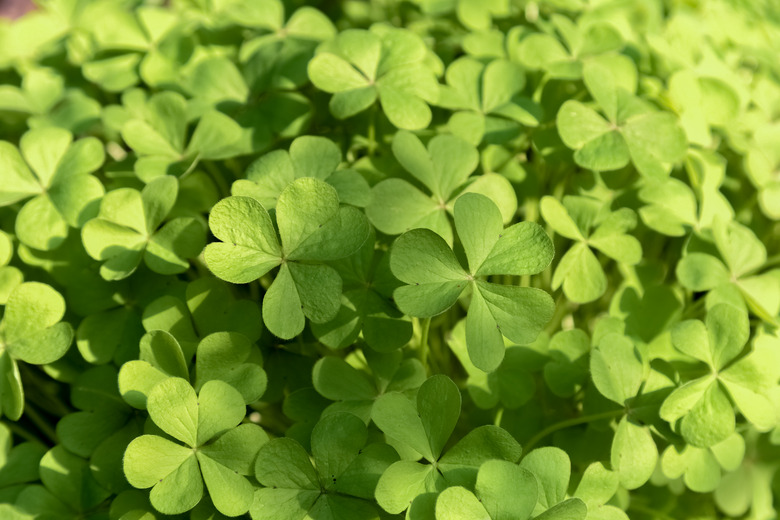How To Care For An Outdoor Shamrock Plant
We may receive a commission on purchases made from links.
You probably know shamrocks (Oxalis spp.) as cheerful green symbols of St. Patrick's Day, but shamrocks also make attractive and versatile garden plants, either planted in the ground or grown in pots. Several varieties are called shamrocks, but the most common is a 4- to-6-inch tall plant also known as wood sorrel (Oxalis acetosella). It grows outdoors year-round in U.S. Department of Agriculture plant hardiness zones 3 through 7, but you can also grow it in a container in colder areas, where it overwinters well indoors. Shamrocks can have invasive plant habits when grown outdoors in optimal conditions.
Watering During the Growing Season
Watering During the Growing Season
A shamrock plant needs a regular supply of water during its growing season, which generally spans through spring, summer, and early fall. If your plant is in the ground, water it when the top 1 inch of soil feels dry to your fingertip. Add a 3-inch layer of organic mulch, such as shredded wood mulch, around the plant to help conserve soil moisture, but keep it back a bit from the plant's stems to discourage the growth of fungus.
If you grow the shamrock in a container, never let its soil dry out. Check the soil's surface with your finger and water whenever it feels dry, allowing the pot to drain completely. Don't keep the pot in a saucer outdoors, because this can fill with water after a rain and promote growth of fungus.
Watering in Winter
Watering in Winter
When fall arrives, a shamrock becomes dormant, stopping its growth and losing its leaves. If you leave the plant in the ground during winter, don't water it. If you leave a shamrock in the ground over winter, set a marker into the soil to indicate where the plant is so you won't damage it during spring planting. You can also dig up the small shamrock bulbs, let them dry for a day or two, and store them indoors in a cool, dry spot until replanting them outdoors in spring.
If you bring a potted shamrock indoors for the winter, you can leave the bulbs in the pot, keeping it in a cool, dimly lit spot. Stop watering once it becomes dormant and the leaves die back. Resume regular watering in early spring when you see the start of new growth.
Shamrock Fertilizer Application
Shamrock Fertilizer Application
Shamrock plants need regular fertilizing to support growth of foliage and their attractive white flowers. To promote heavy flowering, feed the plant with a 15-30-15 water-soluble formula that you dilute at a rate of 1 tablespoon per gallon of water, but also check your product label for further directions. Use the fertilizer solution in place of a regular water and fertilize the plant every two to three weeks while it's growing actively. Once the plant starts losing leaves at the end of the season, stop fertilizing until new growth begins the following spring.
Shamrock Growing Conditions
Shamrock Growing Conditions
Shamrock plants grow best in partial to full shade. Exposing them to too much sun could cause wilting or scorching of the leaves. If you grow them in containers, set them in the shifting shade under tall trees or in a spot that gets some morning sun, followed by shade. Shamrock plants contain a compound called oxalic acid that can harmful when eaten in large quantities, so don't plant it in areas where children or pets play.
Shamrock Plant Diseases
Shamrock Plant Diseases
These plants are usually trouble-free, but they might develop powdery mildew, which causes fluffy white areas on leaves and stems, or fungal leaf spots, which appear as dark, soggy spots on the leaves. Prevent these problems by ensuring good air circulation. Space plants at least 1 foot apart in the ground and keep potted plants separated. Watering at the plant's base to keep leaves dry is also helpful.
Shamrock Plant Pests
Shamrock Plant Pests
When grown outdoors, shamrock plants are usually pest-free, although they might attract leaf miners, insects that tunnel between leaf surfaces, causing visible tracks in leaves. Control these by releasing parasitic wasps (Diglyphus isaea) that feed on the pests near the plants or by placing yellow sticky traps next to the plants to trap adult leaf miners before they lay eggs. Shamrocks can also have issues with spider mites, but they can be dislodged from the plant with a strong blast of water.
